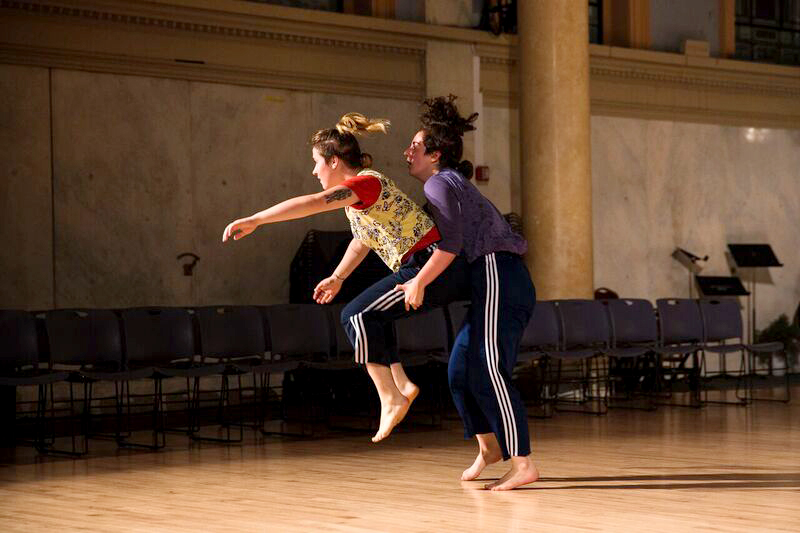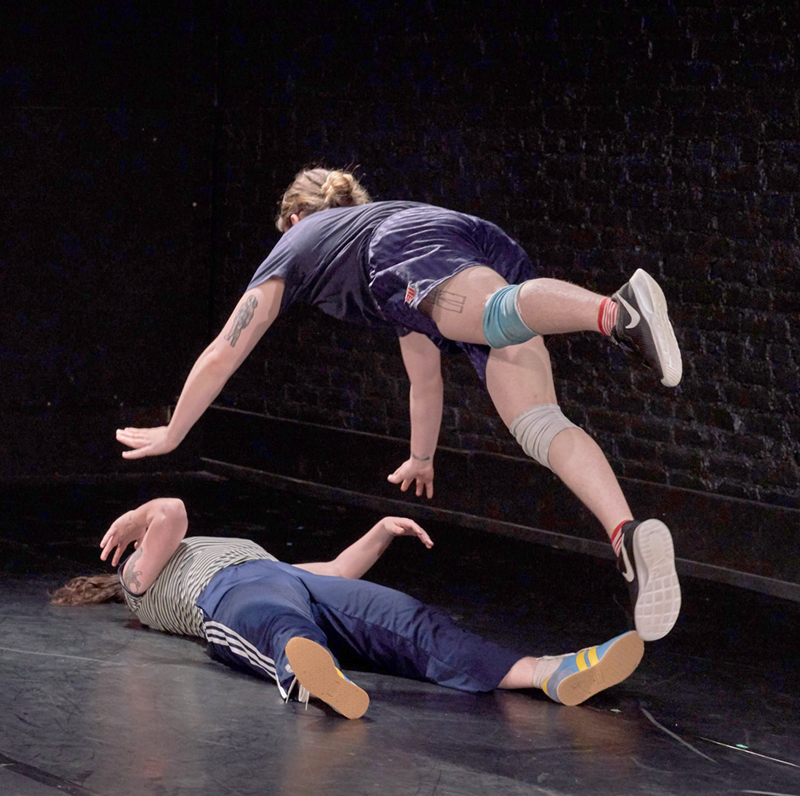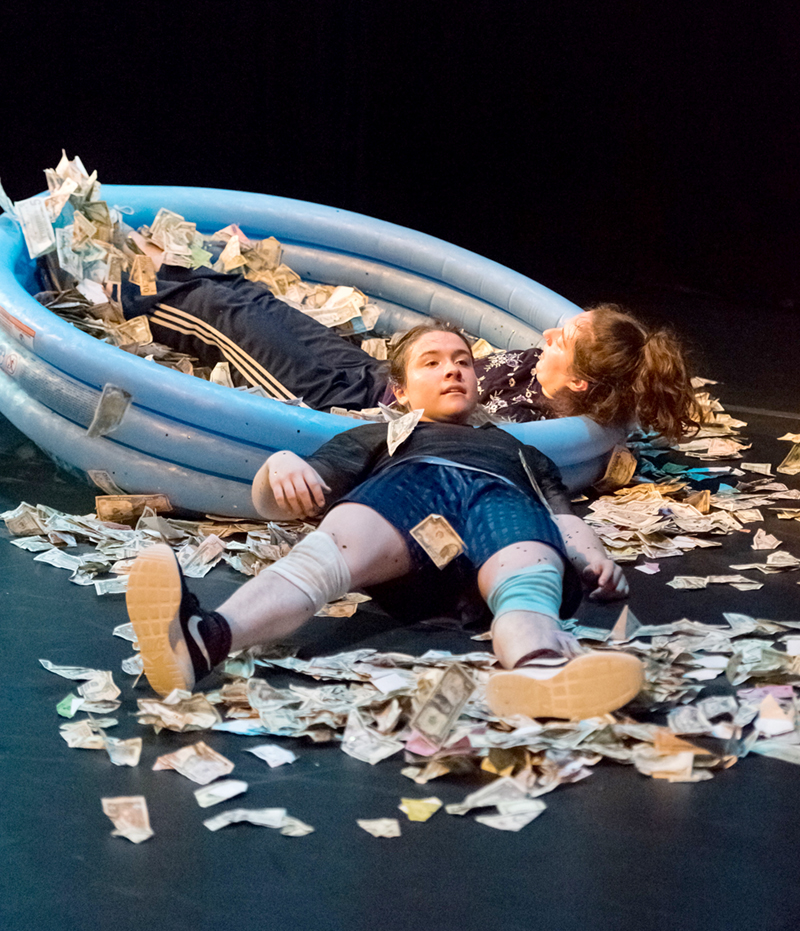Broad, Odd and Embodied
An Interview with Sofia Engelman and Em Papineau
Sofia Engelman and Em Papineau are dance artists in New England who make work based on their queer relationship. Here, they discuss their histories, processes, and how themes of stamina, support and survival guide their work.
Photo by David Gonsier at Movement Research at the Judson Church
~~
Can you share a little about your dance histories – what kinds of performance practices and in what contexts shaped who you are today?
Sofia: I grew up writing a lot of poetry, acting in plays, and drawing and painting with my mom who is a visual artist and art therapist. Engaging with these different modalities taught me a lot about rigor, composition, language and shape-shifting from a young age. I had done a little bit of Isadora Duncan dance in preschool but didn’t really start dancing formally until I was 10. I started dancing again because my parents decided I had to do some sort of physical activity and I didn’t want to play sports anymore. I was really bad at soccer. I remember hating movement as a child; going for walks, playing tag, etc. I started with modern dance once a week and eventually added some ballet. It was movement but it was also heady and creative in a way that excited me. And I was not naturally good at it at all which somehow kept me hooked. I was lucky to be in small classes where I could get a lot of feedback from patient teachers.
After my first year of high school, I went to the Bates Dance Festival’s Young Dancers Workshop (Em and I both went but we missed each other by one summer). I worked with Kyle Abraham, Karl Rogers and Heidi Henderson, and I decided I was going to be a dance artist. I remember in Heidi’s improvisation class sitting on the floor and suddenly realizing it would be dancing if I played with my toes. This was my “Aha!” moment. Karl gave me new ways into doing big moves and Kyle taught me so much about collage and dance and activism. The next summer I was 15 and I went back and made a dance where I ate a tomato while sitting on a blanket with “Take Me Home Country Roads” playing. That was my way in. I studied with Lauren Simpson at my public high school in Cambridge, MA for a couple years. She worked me so hard and always paid the keenest attention to detail. I ended up going to Smith College for dance (where Em and I met), studying a variety of contemporary movement practices intensively with teaching artists including Angie Hauser, Chris Aiken, David Dorfman, Jeanine Durning, Xan Burley, Alex Springer, Jenna Riegel, Jennifer Nugent, Paul Matteson and Shayla-Vie Jenkins. I notice as I list them that many of these artists work a lot with duet forms.
Em: Growing up, I was a very athletic kid. I was involved in many movement practices such as soccer, field hockey, track and field, but I didn’t start dancing until I was eight. I was fortunate to study at Casco Bay Movers Dance Studio in Portland, ME. Under the direction of my beloved teachers and mentors, Kate Marchesseault and Annie Erkinnen, I began to delve deeply into my growing curiosity and love for dance. It was also during this time that I was in a pre-professional repertory dance company called Portland Youth Dance where I was introduced to contact improvisation and other partnered forms. Through this company, I had the opportunity to work with some incredible artists in the contemporary dance field, as well as teach classes and make work of my own.
During high school, I went to Bates Dance Festival’s Young Dancers Workshop where I worked with Sean Dorsey, Karl Rogers and Lida Winfield. It was there that I realized that dance was more than a hobby. It was/is a lens in which I view the world, a way to build family and community, a way to move and work through trauma. However, I do believe that I grew the most as a dancer/choreographer/director at Smith College (where Sofia and I met). At Smith, I worked with Chris Aiken, Xan Burley + Alex Springer, Jeanine Durning, David Dorfman and Jenna Riegel. I also created and performed in three works with Sofia which we were fortunate to be able to tour around the East Coast, then San Francisco and in Germany.
How would you generally describe your work to someone unfamiliar with it?
We make duets that we perform together. These dances create and require a particular state of togetherness through active negotiation, hopeless dependency, and acts of trust and survival. Our work is full on dyke partnering. We make dances that have dance moves, words, objects, and lots and lots of love. Right now, we are grappling with what it means to need each other. We are grappling with joy. We are often in contact. We do dance moves that are set and dance moves that are improvised. Some of our set dance moves look improvised. It’s a queering of sorts. We actively maintain and cultivate disruption, dissonance and disjunction. It’s not that we hate each other. It’s just that these works are not about that kind of beauty.
Photo by James Lastowski at Providence Movement Festival
What does your choreographic process look like?
We like to interrogate the notions of productivity that have been instilled in us by our culture, the field, and our teachers. Sometimes we go to the studio and we don’t dance. Other times we do, but spend most of our rehearsal time laying together, talking, watching videos of work we like, or arguing. Maybe twice during the process of making a given work will we have a magical rehearsal where we dance non-stop for at least two hours and everything feels effortless. We are learning that these magical rehearsals and these “lazy” rehearsals are both valuable ways of being together in the studio. There is a rigor in deeply listening to the needs of ourselves and the work, and in not forcing logic, sense or traditional forms of productivity. This permission allows for a different kind of ease and ability to dive into a project thoughtfully with patience, love and our whole selves.
Because of our love and need to indulge in states of distraction and refusal, our works are usually made in spurts. We like to create deadlines for ourselves which require us to perform something before we and it are ready. When we show fresh material in front of an audience, we learn so much about it immediately. We learn what we like and what we don’t like and what belongs together in the same world. Connections reveal and forced connections disintegrate. There tends to be something improvisational about our set dances.
We also like to engage in a practice of un-silencing. Our dances tend to be physically vigorous and we choose to allow ourselves to make sounds and communicate verbally as we dance them. This is an improvisational score that sits on top of our works. Un-silencing allows us to be further present (together) as performers.
Are there certain themes or issues that feel important to you to keep tackling or addressing in your work?
An inevitable theme in our performance work together is queerness. When we are onstage together, our queerness is what people see. We are interested in queer choreographies in a structural sense of dealing with ideas of orientation, futurity and world-building, ephemerality, and failure and mess in our movement invention, composition and crafting of moments. We find that we must allow our relationship to be part of the work in order to move through it and get at something more universal. We need to acknowledge our us-ness and our together-ness and, once it’s acknowledged, we can go deeper. So our relationship is part of our dances but our dances are never meant to only be about us. Our relationship is a consequential theme and it becomes a vehicle or a container to go somewhere.
We’re also thinking a lot about stamina. What are our abilities if we only need to do something for a short period of time? How long can we take on the impossible or the risky? We’re looking at re-routing our habits into unknown patterns. What if Sofia stands in a familiar position and Em does something Em has never done before? Where does this fresh impulse come from, how long does it take for it to arrive, and how can we call upon these new instincts faster? We want to see as many beginnings and pathways as possible at once. Our last dance, INSTANT SAVIORS (just add water), was about survival and it seems our next one is too. These explorations around seeing and feeling our options are tools for survival.
We often identify subjects of our work by noting what is naturally coming up in our movement in the studio. When making INSTANT SAVIORS (just add water), we noted ‘support’ as a key theme. Support was what was happening physically and emotionally in the studio through full bodied lifts and careening weight shifts. Support seemed to have a contentious relationship with notions of dependency; if we were making work where we relied on each other, when did we become too reliant? What did it take to trust the other to keep one safe and to trust oneself to keep the other safe? We ultimately observed our reliance to be a survival tactic. It was a tactic for survival within the work because we needed each other in order to safely execute the movement, but more broadly, dependency seemed to serve as a way to survive as citizens in an increasingly isolating and anxious global society. Survival as a theme may be unavoidable for us as we make work in the United States at this time. We survive, save each other from, and support each other through boredom, anxiety, outside dangers, current trends, capitalism and reckless ideas.
What can allies – studio owners, presenters, festival organizers, etc. – do to help create queer visibility in their own niches of the dance world?
‘Queer’ is a beautiful term because it can encompass and bind together a multiplicity of identities. However, it is also so important for gatekeepers to hold space for the specificity of different queer experiences. Not all queer people experience the same kind of erasure in this field; white able-bodied cis gay men get programmed into contemporary dance spaces A LOT and disabled trans people of color aren’t seen remotely enough. Queer people don’t speak for all queers or know what it’s like to be every queer. Remember that presenting one queer artist will not tick all your boxes. Bring in a lot of people! Make it normal. Be sure that you have queer panelists involved in the curation of your event or space; work with them to choose artists who are interesting and who will help expand your organization. It’s important to do some unlearning of what “good” dance is and to reexamine your judging criteria. However, avoid bringing in artists just because they are queer. This field was created by (and for) magnificent queers: Ted Shawn, Katherine Dunham, Yvonne Rainer, Steve Paxton, Alvin Ailey, Lucinda Childs, Merce Cunningham… Remember and honor this history. This is our space. It is also so important to present queer people who make work that doesn’t necessarily showcase their queerness and those who make work which articulates their queerness in complex, confusing or subtle ways. We all manifest ourselves in different ways. Queerness is broad and odd and all about embodiment. Just like dance.
Photo by Derek Fowles at Smith College
~~
To learn more, visit www.engelmanpapineaudance.com.



